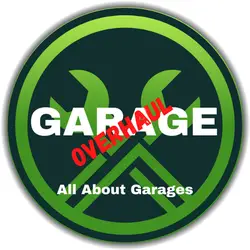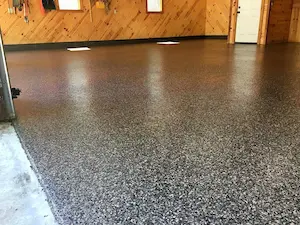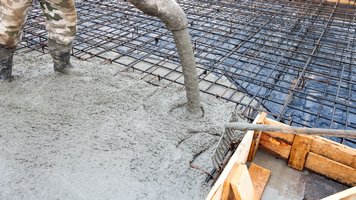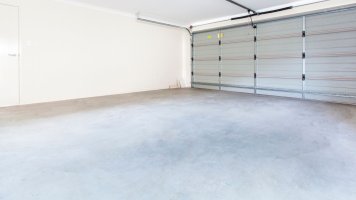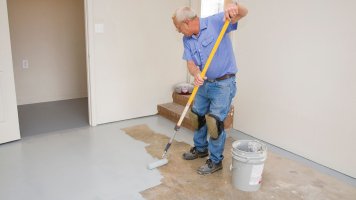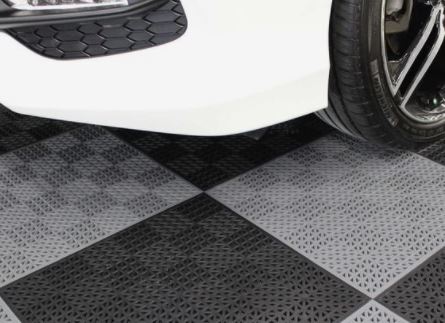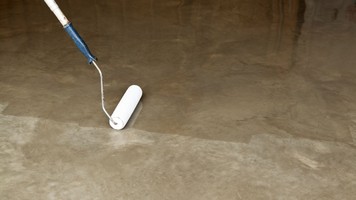Garage Flooring Guide: Stains & Dyes (What’s the Difference?)
This post contains affiliate links.
Acid staining or color-dyed garage floor will completely change the whole look of the garage. These are translucent color additives for concrete that can create multiple color hues with vibrant colors. Both methods are great budget solutions for those who want something else in their garage other than just a gray concrete floor.
Stains contain acid and metallic salts. These react with the Ca(OH)2 in the concrete to produce coloring. The color palette consists of earth tones and makes a marble or mottled appearance. Dyes consist of water with polymers and pigments to create the color. Having a more extended color palette and producing a uniform effect.
In this article, we look at the difference between both methods, how to choose one and how to apply them.
Stained/Dyed Garage Concrete Floors
Stains and dyes are a popular DIY trend nowadays. No two floors will look alike because the regional concrete mix, density, porosity, and finishing process for each concrete slab varies. So stains and dyes react differently to the concrete.
You can apply one single color or multiple colors that create a unique color palette. The color will be permanently attached to the surface of the concrete. Stains and dyes also don’t crack, peel or delaminate.
The surface should be sealed after application with clear topical sealers, which will protect the stained or dyed surface. The sealer will also make the colors pop. You can use non-film-forming sealers, but they will not protect the colors from wear and tear and will not make the colors pop out more.
Also, keep in mind that most concrete stains are translucent. And will not hide spider cracks, discolored concrete or crack repairs, and other irregularities in the floor surface. Instead, they will highlight all minor imperfections on the floor, creating a unique character to the floor that some people desire.
Acid Staining and Color Dyes for Garage Floors
Understanding the difference between both methods is important as “stained concrete” is a term that is loosely used in the industry. And may not necessarily define what method was used to color the concrete.
The terminology is not as important when you know the features of both and how they work. Each has its own requirements for the application and will produce different finishes with its own color characteristic.
There are two basic types of concrete stains:
- Acid-based stains contain hydrochloric acid and metallic salts. Both elements react with the calcium hydroxide (Ca(OH)2) in the concrete to produce coloring. The color palette consists mainly of earth tones, and they make marble or mottled appearance.
- Water-based stains consist of water with polymers and pigments that are added to create color. They have a way more extended color palette and produce a uniform effect.
Acid Stains for Garage Floors
Acid staining has been used for years to color the concrete. Acid staining is a chemical method that consists of hydrochloric acid, water, and acid-soluble metallic salts, which work as the colorant. They penetrate the surface of the concrete and cause a chemical reaction with the hydrated lime present on the surface.
The concrete surface is slightly etched with the process. The metallic salts are deposited into the surface, producing a permanent translucent natural-looking color. They are often marbled or mottled beautifully.
The coverage rate is approximately 250 square feet per gallon. The rate can be increased with multiple applications.
Colors are limited to basic earth tones because acid stains are organic.
Concrete surfaces will affect the intensity of the color in some cases. Dense and very smooth concrete will not allow the stain to penetrate and react to the surface so much. So the coloring effect can be very light. The more stain penetrates the surface, the richer the color will be.
Application of Acid Stains to the Garage Floor
The application of acid stains is a time-consuming process.
- Acid stains need to be agitated with a deck brush or broom during application to ensure better penetration and strong reaction with the concrete. Acid stains also need to dwell for a minimum of 5 hours to be effective.
- You then determine if more stain needs to be added to make the color richer or darker or add a different color to the mix.
- Acid stains produce strong fumes and need good ventilation during the process.
- When the staining process is completed, the surface must be washed, scrubbed, and neutralized with an ammonia solution or alkaline soap. This is an important step and should not be overlooked ever.
- Scrubbing removes the unreacted acid and stain residue. The alkaline solution neutralizes the acid and returns the concrete from the acid state to its natural P.H. state. Sometimes multiple scrubbings are needed.
Acid stains cannot be applied to already sealed concrete. The sealer limits the penetration and acid reaction to stain the surface effectively. The sealer needs to be removed by grinding.
Grinding can also remove most of the free lime, which the stains react with to impart its color. So if your garage has been previously sealed. The removal of the sealer and application of concrete dye might be the better choice.
Concrete Dyes for Garage Floors
Dyes can be either water-based or solvent-based. If colored concrete stains are not acid-based, it’s generally considered a dye. Some water-based concrete colorants are sometimes referred to as stains, so the terms may cause some confusion.
Again the terminology some manufactures use is not as important. The important part is how water/solvent-based dyes work compared to acid stains.
Concrete dyes are nonreactive, unlike acid stains. Dyes penetrate the concrete to insert their color pigments into the pores, crannies, and nooks on the concrete surface. The pigments are tiny compared to acid stains, so you get higher color saturation.
Dyes are not organic like acid stains, so many more color options are available to choose from. Other than just basic earth tones with acid stains.
Coverage rates for concrete dyes are up to 300 square feet per gallon. Multiple applications increase up to 400 square feet per gallon.
Water-based dyes are more commonly used for garage floors than solvent-based. Water-based dyes produce soft colors and hues that are translucent similar to acid stains.
Solvent-based dyes produce brighter coloring with a less translucent effect. They are not as U.V. stable, and the color can fade in direct sunlight.
Dyes can be used in conjunction with acid stains to darken the parts of the concrete if needed. Dyes can also be used to create a worn or weathered look on the floors. They are also used for shading and 3d effects.
Application of Concrete Dyes to the Garage Floor
The application of concrete dyes is faster than acid stains.
- Concrete dyes take 1-2 hours to dry before you determine if you need more color.
- The concrete does not need to be neutralized afterward.
- Cleaning and scrubbing are not usually required also.
Sealing Acid Stained or Color Dyed Concrete
Selecting the suitable clear coating sealer for dyes or acid stains is very important because the sealer protects the stain or dye. The durability of the coating is vital. The sealer also plays a significant role in how the floor stands up to wear and tear from everyday usage. The garage environment needs more protection than just basic foot traffic.
Consider the concrete preparation work required for the sealer. Many coatings require the concrete to be etched first. So that the clear coating will adhere properly. It is also essential to know how the dye or stain will work with the clear coating sealer.
If you don’t want to etch the concrete, you need to use clear coats that do not require etching. Dyes that can penetrate the surface do not need surface prep.
- Etching the concrete before dye increases the choices for clear coatings.
- Etching opens the concrete pores, and you need to use more dye.
- Acid staining itself etches the concrete.
Sealers That Do Not Require Etching
These clear coat sealers can be applied to floors that are color dyed/stained.
MMA Acrylics – (methyl methacrylate copolymer) acrylic resin is a high-gloss solvent-based acrylic coating. Much more durable than water-based and non-MMA solvent-based acrylic clear sealers. Resist stains and chemicals. U.V. stable and can handle hot tire pickup.
Acrylic Modified, Aliphatic Polyurethane Sealers – Sealer for stained or dyed concrete. Superior durability to MMA acrylics. U.V. stable and offers superb protection to fluid, salt, and chemicals. Can handle hot tire pickup.
Single component, Moisture-cured Polyurethane Coating – More durable than modified acrylic polyurethanes. It can handle hot tire pickup and has excellent resistance to wear, chemical, and salts. U.V. Stable.
Read all about sealers in this article.
Sealers That Require Etching
If you etch the floor or use acid stains before coating it with sealers, you have more choices for clear coatings. All the sealers that do not require etching will work too.
Water-Based Epoxy – Available in matte to semi-gloss. Provides good resistance against oil, fluids, salt, and chemicals. Epoxy is not U.V. stable and, if exposed to direct sunlight for long periods, can turn a slight yellow tint affecting how the colors look from the dyes and stains. Hot tire pickup can be an issue, too, with some low-grade DIY water-based epoxies.
Solvent-Based Epoxy – Thicker than water-based epoxies offering better resistance to chemicals, salts, fluids, and oil. Slightly better wear and abrasion resistance too.
Single-Part Polyurea: U.V. Stable moisture-cured polyurea offers high performance highly resistant to chemicals, oils, salt, and fluids. Has good abrasion resistance, and it will last a long time. Easy to apply.
Read more about sealers here.
Characteristics of Stained or Dyed Garage Floors
Concrete stains and dyes highlight the imperfections in the concrete floor. This includes all the repairs made to the floor beforehand. Repairs like cracks or spalling, pitting, and filling of divots.
Small divots, spalling, or pitting can be repaired with a polymer-modified cementitious repair that perfectly accepts stains and dyes. But the coloring effect will still be different from the surrounding concrete.
Crack repair materials are usually made of epoxy or polyurea. These are resistant to staining and will not accept color, so such repairs will stand out.
If you have discolored concrete from cleaned oil stains will also look different from surrounding concrete after staining or dyes.
These are not necessarily something to avoid. But something to consider when choosing the color of the floor.
If your garage floor needs many repairs and you don’t want the repairs to stand out. You may want to consider something more concealing coating than translucent coatings like stains and dyes.
You can also not repair minor cracks, pits, and other irregularities in the floor, so you create a more natural and soft look to the concrete. This style goes great with the earth tone colors giving the floor a weathered or broken-in appearance. Finish off with matte or semi-gloss sealer to create a unique floor with lots of character.
Avoid grinding the concrete if you can. Swirl marks from the grinding will be highlighted nastily. If you absolutely need to grind. Follow up with a second grind with finer 100-120 segmented diamond discs to smooth out the swirl marks.
Prepping the Garage Floor for Stains and Dyes
First, you need to test if your floor will accept acid stains or dye. Get a pump-up garden sprayer and fill it with water.
- Apply a heavy mist of water all over the concrete surface and observe how well the water absorbs into the surface. If the concrete absorbs the water in a few minutes, it will accept the stains and dyes.
- Take note of the areas where the water beads or sits a long time. These areas will not accept the stains. Mark the areas because they need to be sanded to allow the dye or stain to penetrate the surface.
For small areas, use a handheld orbital sander. If there are large areas, a floor maintainer with 60-80 grit sanding discs works well. The goal is to break up the too-smooth surface so the stain can penetrate the concrete.
Other contaminants like oil or chemical spills have to be degreased and cleaned properly.
Some acid stain manufacturers include a prepping solution that will mildly etch the floor beforehand to better penetrate the stain itself. They are designed to not disturb the free lime required for the acid stains to bond correctly.
When all concrete repairs and penetration issues are solved, clean the concrete as thoroughly as possible. Any dust, dirt, or other particles will prohibit the dye or stain from working and bonding correctly.
Read the manufacturer’s instructions and follow them strictly when applying stains and dyes. This way, you avoid cosmetic problems.
- Tape off the walls when working indoors or cover the vegetation when outdoors.
- Get a quality pump-up sprayer with a conical spray nozzle. It is the best tool for applying both acid stains and concrete dyes. Avoid cheap ones that can drip or deposit droplets into the surface when the trigger is pulled and released. Drips create cosmetic issues fast.
- Test the spray pattern in a large bucket first. Start the spray from the bucket and quickly transfer it to the garage floor. When you stop the spray, quickly move it back to the bucket. This method will prevent errors with dark droplets.
- Brush or roll out any heavy lines of drips created by the sprayer. If you leave them too long, they will stand out in the final finish.
When the dye or stain has sat long enough, you can apply more or add multiple colors.
When applying multiple colors. Start from the lightest color first. You can not lighten a darker color dye or stain with a lighter color.
- Always wear protective equipment like rubber boots & gloves, eye protection, and long pants.
- Do not step into the stain or cause heavy puddling!
- Use pump-up sprayer approved for acid stains!
- Acid stains are applied at a flow rate close to mist.
- Water-based stains and dyes require a heavier flow rate.
Let the concrete dry thoroughly before application of the sealer. If you used acid stains, you might need to wait up to 48 hours.
All the water needs to evaporate out of the concrete. If you don’t let the water evaporate, the clear sealer can trap bubbles from the moisture vapor.
How Much Does It Cost to Stain Concrete?
Typically, staining concrete costs between $7 and $15 per square foot. Contractors charge between $2 and $4 per square foot for a simple stain job and between $12 and $25 per square foot for a high-end design. (source homeadvisor.com)
Acid Stain Concrete Cost
Acid-based stains are also referred to as “reactive stains” and cost around $6 per square foot for a basic design. (source homeadvisor.com)
Water-Based Stain Cost
Water-based stains are also referred to as “nonreactive stains” and cost approximately $2 per square foot for a solid color stain. (source homeadvisor.com)
Stained Concrete Price Per Square Foot
The cost of stained concrete depends mainly on the level of service. This includes the cost of design, materials, and labor. (source homeadvisor.com)
| Level of Service | Cost Per Square Foot | Included Services |
|---|---|---|
| Basic | $2-$4 | Minor slab prep Single color Final sealer coat |
| Intermediate | $4-$10 | Minor slab prep Two colors Final sealer coat |
| Upgraded | $8-$15 | Slab prep Multiple colors Intricate patterns |
| High-end | $12-$25 | Slab prep Stencil work & sawcuts Hand-finished stains |
How Much Does It Cost to Stain Concrete Floors Yourself?
DIY concrete staining costs between $0.30 per square foot and $0.40 per square foot. (source homeadvisor.com)
Things to Consider in Stained or Dyed Garage Floors
Get sample color kits from vendors that sell acid stains and dyes. Test a few colors in an inconspicuous garage floor area before proceeding to do the whole floor. The sample kits will give you an idea of how the stain or dye will look.
Keep in mind the colors will appear slightly dull before a clear coat is applied. Apply some water to the surface to understand how the sample color will look with the clear coat applied. After the stain has dried.
Multiple colors can look great. Just don’t overdo it by mixing too many of them. You might get just a dark brown tone that way.
You can also use penetrating sealers, densifiers, or other non-film-forming sealers with acid stains or concrete dyes. But they will not make the colors pop, and the colored surface will not be protected very well from wear or scratches.
Stains and dyes are relatively inexpensive. The most expensive investment is a clear coat sealer that will determine how well the floor lasts years to come. So purchase the best sealer that your budget will allow.
Stains and dyes are fun projects that will totally change the look of the garage for little elbow grease. They are an excellent option for garage floors.
Check out the other articles in the floor series to get more ideas.
